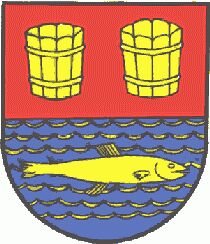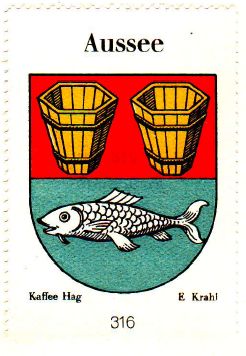Bad Aussee: Difference between revisions
Knorrepoes (talk | contribs) m (Text replace - "Österreich" />" />" to "Österreich" />") |
Knorrepoes (talk | contribs) m (Text replace - "[[Literature" to "{{media}} [[Literature") |
||
| Line 22: | Line 22: | ||
|align="center"|[[File:aussee.hagat.jpg|center]] <br/>The arms in the [[Kaffee Hag : Die Wappen der Republik Oesterreich|Coffee Hag album]] +/- 1932 | |align="center"|[[File:aussee.hagat.jpg|center]] <br/>The arms in the [[Kaffee Hag : Die Wappen der Republik Oesterreich|Coffee Hag album]] +/- 1932 | ||
|} | |} | ||
{{media}} | |||
[[Literature]] : Image provided by Karl Palfrader (k.palfrader@aon.at), MStLA 47 (1997), 35 | [[Literature]] : Image provided by Karl Palfrader (k.palfrader@aon.at), MStLA 47 (1997), 35 | ||
Revision as of 18:21, 8 July 2014
| Heraldry of the World Civic heraldry of Austria - Österreichische Gemeindewappen |
BAD AUSSEE
State : Steiermark
District : Liezen
Origin/meaning
The arms were granted on April 25, 1994.
Bad Aussee was granted the use of a seal by Emperor Maximilian I in 1505. In 1994, the city was formally re-granted the motif of the seal as a coat of arms.
Bad Aussee has always had a special position. Since the Middle Ages, the city was the site of one of the great Austrian saltworks. The mining of salt was a state monopoly and the profits have always been important. The two wooden buckets (Salzkufen) were used to transport brine and fresh salt. The fish is a Saibling, a species characteristic to the Grundlsee near the city. In times past, the Dukes of Styria used to levy annual payments in kind to be delivered in Saibling fish which make very good eating.
| The arms in the Coffee Hag album +/- 1932 |
Contact and Support
Partners:
Your logo here ?
Contact us
© since 1995, Heraldry of the World, Ralf Hartemink 
Index of the site
Literature : Image provided by Karl Palfrader (k.palfrader@aon.at), MStLA 47 (1997), 35












